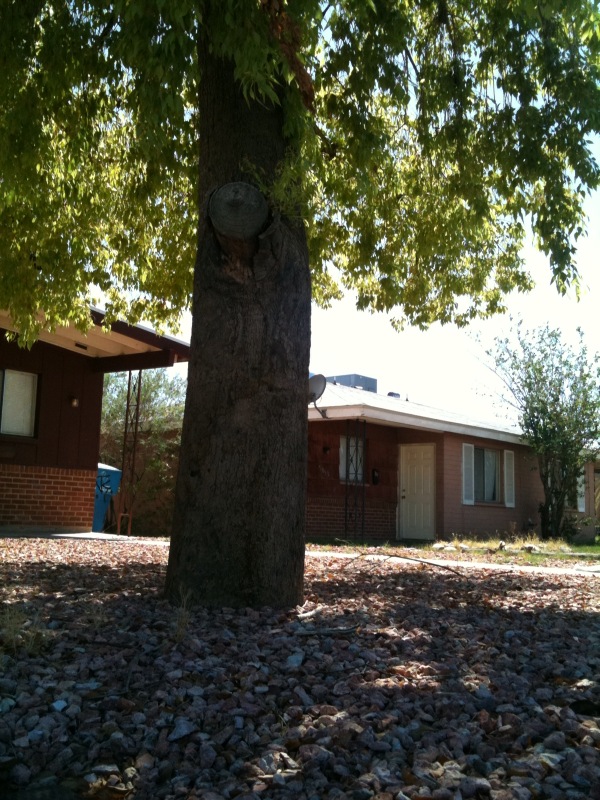 Last week, in the third installment of the series on the Tree and Shade Masterplan, I promised to talk about steps 2 and 3 in the implementation of the plan. But I’ll talk about those things next Wednesday and this is why: just a few hours ago I had lunch with the authors of the marvelous Tree and Shade Masterplan – Ken Vonderscher, Richard v-C Adkins, and Lysistrata Hall – and I learned so much from them that I wanted to share it with you today, while it’s fresh on my mind. Ken, Richard and Lysistrata all work for the Parks & Recreation Department at the City of Phoenix.
Last week, in the third installment of the series on the Tree and Shade Masterplan, I promised to talk about steps 2 and 3 in the implementation of the plan. But I’ll talk about those things next Wednesday and this is why: just a few hours ago I had lunch with the authors of the marvelous Tree and Shade Masterplan – Ken Vonderscher, Richard v-C Adkins, and Lysistrata Hall – and I learned so much from them that I wanted to share it with you today, while it’s fresh on my mind. Ken, Richard and Lysistrata all work for the Parks & Recreation Department at the City of Phoenix.
Here’s what I learned:
- The Phoenix Tree and Shade Masterplan is being recognized nationally and Richard will be presenting it at the 2010 Partners in Community Forestry National Conference in Philadelphia later this year.
- Much of the land in Phoenix is private property, so the key to the success of this Masterplan is in educating people to become stewards of existing trees and how to plant the right trees in the right areas. The City will lead by example on their own projects and City-owned land, but they can’t do it all by themselves.
- The Parks & Recreation Department is working with many different agencies and organizations to spread the word about the Tree and Shade Masterplan, such as ASU, the City Planning Commissions, regional Municipalities, and organizations like the Phoenix Community Alliance.
- Since trees are solution multipliers, meaning they solve many different problems at once, the Tree and Shade Masterplan must be a multi-disciplinary plan addressing things like the heat island effect and water usage.
- The Parks & Recreation Department is in a process of experimentation to see how to fully integrate trees into our urban landscape so that they provide us with a lush tree canopy for a long time to come. The final answer to this is not all figured out yet, but as the importance of a healthy urban forest becomes more widely accepted, this experimentation will yield the right solution.
- We have 30 to 40 tree species available to us that are appropriate for this climate and region.
- The goal is to achieve 25% shade in Phoenix in 25 years. This means that 25% of our city will be under shade, where currently less than half of that is in shade.
- The City will be undergoing a Tree Inventory starting this month, an effort Richard will be leading. The inventory will account for trees, where they are, their species, their age, their value and so forth. This will be a key first step to achieving the goal of 25% shade in 25 years. The plan is to have much of this inventory available online.
- The problem is not that people and businesses don’t plant enough trees. The problem is that they don’t plant them in the right way. According to Ken and Richard, many times trees are planted too deeply and they end up dead in a few years. Once they’re dead, they rarely get replaced. This is why education is such a key component to restoring the urban forest.
- A very good example of how trees should be planted in our city is the Civic Space Park in conjunction with Taylor Mall in Downtown. I’ll be doing a feature on why that is coming up soon here on the Blooming Rock blog.
Here are a few tree-related links that the authors pointed me to if you want to help put the Masterplan into action:
Hands on Greater Phoenix – for tree plantings
Arizona Community Tree Council – important information about the care and planting of trees
My City – My Park – the Park & Recreation Department’s Volunteer Program
Sustainable Cities Network – a coalition between ASU, the City, the County and Tribal Leaders to further sustainability in the region
If you want more specific information on how you can help, contact Lysistrata “Lyssa” Hall at lysistrata.hall@phoenix.gov.
Photo Credit: A photo of a tree in my neighbor’s yard that appears to be planted too deeply (but I’m no expert). Photo by Taz Loomans.




















[…] This is the step that is currently under experimentation as I mentioned in last week’s installment. Because we live in a desert, it’s difficult to figure out which trees are best for our […]